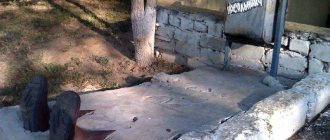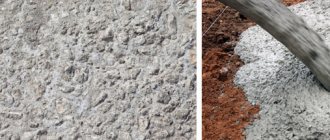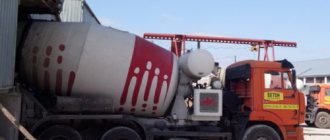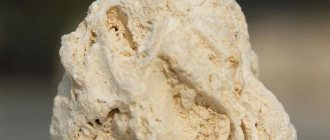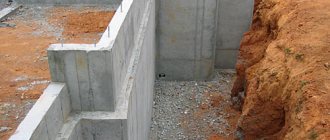Concrete M250 is one of the types of mortar used in the creation of various industrial/residential facilities, structures, elements, etc. The mixture is not one of the most common brands, along with M200 and M300, but it demonstrates good performance characteristics, and therefore is relevant for the implementation of certain tasks.
The M250 demonstrates similar technical characteristics to the M200 in terms of mobility, frost resistance and water resistance, but other indicators may be slightly higher. At the same time, the properties of the solution are inferior to those of M300, while the cost is almost the same.
Therefore, many craftsmen do not see the point in such savings and choose M200 or M300 for certain jobs. However, M250 grade concrete also finds its application in certain areas.
Specifications
Concrete 250 is a cement mortar prepared from standard components in a certain proportion. Subject to the concrete production technology, the mixture demonstrates certain characteristics and properties prescribed in the standards and standard for a given type and class of material.
The main parameter of the mixture, which determines the scope of its use and performance qualities, is strength.
To determine the strength, hardened cement stone (a piece with a side of about 15 centimeters) is subjected to pressure tests. This is how the average force directly applied per square cm of the prototype monolith plane is determined. The material is able to withstand this force under pressure without destruction.
The indicator obtained in this way is close to the standard marking and must be indicated on the packaging of the material, as well as in documents and GOST. Concrete grade M250 demonstrates a compressive strength of 262 kgf/cm2.
Thanks to crushed granite, concrete B20 M250 demonstrates water resistance up to W6; this indicator can be increased by introducing special additives into the composition (plasticizers, water repellents, pozzolans, etc.).
The density of B20 concrete is fixed at 2350 kg/m3, which is why the M250 grade is considered heavy. It is worth noting that the specific gravity of the material is determined directly by the selected proportion of the components taken during mixing. Also, the density indicator is largely influenced by factors such as the presence of seals, the type and fraction of fillers, the method of compaction, etc.
Other characteristics of the M250:
- Concrete class M250 – the considered building mixture corresponds to a value of B 20. This parameter is determined during compression testing of standard test samples. The number 20 is evidence that in 95% of cases a sample made of M250 concrete is capable of withstanding a pressure of 20 MPa (the same compressive strength - 200 kgf/cm2 and up to 262 kgf/m2).
- Frost resistance – F100-F150: that is, B20 concrete can withstand 100-150 freezing/thawing cycles without losing its qualities. The indicator can increase due to the introduction of special additives into the composition.
- Mobility – P2-P4: depends on the specific requirements of casting, the selected components for mixing, affects the ease of working with the solution.
- The weight of concrete is within 2300 kg/m3, but the final figure directly depends on the composition of M250 concrete and the type of aggregate.
- Cost - quite strongly depends on the specific manufacturer, region, exact technical characteristics (compressive strength, hydrophobicity, ability to withstand sub-zero temperatures, mobility are usually determined), within Moscow and the region it is 4250-4400 rubles / m3.
The cost of making the mixture yourself will be significantly lower, since the price of the prepared concrete solution in a factory includes such items as: employee wages, depreciation of buildings, tools and equipment, structures, electricity payments, taxes, contributions to state funds and other production and production costs. non-production type.
The characteristics of B20 concrete make it possible to classify it as heavy - the mixture is most often used in civil engineering.
Concrete m 250 GOST
Many types of concrete are used in construction, varying in composition and characteristics. It is common to think that only mortar of a grade not lower than M300 and even M400 is suitable for the construction of structures of private and apartment buildings. However, their use is not always justified from the point of view of the safety margin, and therefore is not economically feasible. For some cases, concrete M250 is suitable - a practical and reliable material.
Specifications
When choosing concrete for construction, specialists primarily focus on its technical parameters. They are regulated by the above-mentioned GOST 26633-2012.
According to the new standard, concrete M250 corresponds to class B20, so it is marked with the double designation M250 B20. At the same time, the brand indicates the maximum possible load on a mature stone, and the class indicates the average load with a margin.
Technical characteristics of concrete m250:
| Index | Units | Meaning |
| Maximum strength | kg/cm 2 | 260 |
| Density (density of concrete) | kg/m 3 | 2300-2400 |
| Frost resistance | Cycles, F | 200 |
| Waterproof | W | 6 (waterproof) |
| Solution mobility | P | P2-P3 |
Concrete composition
The properties of the components for mixing the mortar are carefully described in GOST R 7473. Preparation of concrete grade M250 requires precise adherence to proportions and selection of the right ingredients.
Composition of concrete M250:
- Cement - as in other building mixtures, here acts as a binder and directly affects the properties of the solution. Usually choose cement grades M400-M500, with the correct release date (maximum 6 months before use) and properly stored.
- Fine aggregate - it is sand of the first/second class. For the M 250 solution, the sand is cleaned of dirt and impurities (especially clay, which significantly worsens the final quality of the mixture). The best choice would be sand of fraction 2-2.5.
- Coarse aggregate - you can take crushed limestone, granite, but most often gravel (this material is usually chosen because it offers the best price-quality ratio).
- Water – experts advise using purified water to be sure of the quality of the concrete mixture.
- Additives – antiseptic, hydrophobic, sealing, etc. All of them are designed to improve certain performance characteristics of class concrete
The optimal proportions of M250 concrete are: part cement, 2.1 parts sand, 3.9 parts crushed stone. If this ratio is observed, from 10 liters of cement you can get 43 liters of ready-made concrete mortar.
Making the solution
The components are mixed in the following proportions: cement - 1, crushed stone - 4.6, sand - 2.6. If the composition is followed, 10 liters of cement powder are required to produce 43 liters of concrete.
To obtain 1 m³ are used:
- 330 kg of cement;
- 140 l of water;
- 1100 kg of crushed stone;
- 740 kg of sand.
The amount of additives and impurities should not exceed 5% of the solution volume. To increase the resistance of the composition to frost, the volume of water is reduced, but the amount of cement and plasticizers is increased.
All components must be thoroughly mixed. At home, the composition can be made only using a gravity concrete mixer. It is impossible to do this without the use of technology - the resulting material will be of poor quality.
The strength of the composition depends on the quality of its components. Cement that has passed its expiration date or has been stored openly is not suitable for use. It absorbs moisture from the environment and clumps, which impairs its strength.
When purchasing cement powder, you need to carefully inspect the bag. It must be intact, without any sealed areas or damage. You should pay attention to the storage conditions of cement. It is best to buy components for making mortar in large construction stores, where the rules for storing materials are followed.
Proportions
Calculating the proportions of grade 250 concrete is easy. In this example, the components will be taken in standard volumes, based on the following conditions: cement corresponds to grade M500, purified water, granite crushed stone of fractions from 5 to 20 acts as a coarse aggregate, and river sand without any impurities or clay as a fine aggregate.
Ideal proportions:
- By weight (in kilograms, for example): 1 kilogram of cement, 2.6 kilograms of sand, 4.5 kilograms of crushed stone, multiplied by the desired final result.
- By volume: 1 part cement, 2.4 parts sand, 3.9 parts crushed stone.
In order for the concrete to harden perfectly and then not have to find out during the research process what grade it turned out to be, you need to add about 30% of the weight of the cement with water. True, such a solution will be difficult to install due to dryness, so usually concrete B20 (M250) assumes a water-cement ratio within 0.62 (provided that M500 grade cement is used).
Concrete M250 according to GOST
What class does the M250 brand belong to?
The M250 marking reflects the compressive strength of the material. According to GOST 26633, this brand belongs to strength class B20 (that is, a cubic sample after hardening can withstand a pressure of 20 MPa with a 95% probability ). The average strength of concrete is 261.9 kgf/cm2.
Concrete marking
The symbol of such a brand must indicate the type of concrete, as well as standardized characteristics and GOST. For example, heavy concrete (HCT) is marked as follows: BST V20 P2 F150 W8 GOST 7473-2010, where:
- B20 - compressive strength class;
- P2 - mobility grade;
- F150 - frost resistance grade;
- W8 - waterproof grade;
- normative document.
Additional standardized characteristics
Structures made of concrete or reinforced concrete can be operated under specific conditions (for example, when exposed to moisture or freezing temperatures). In this case, the following characteristics play an important role:
- waterproofness W. Most often, customers prefer to use brands W6, W8;
- workability, which is expressed by the mobility indicator (P2, P3, P4);
- the average density according to GOST 25192 is indicated by the letter D and the density indicator;
- frost resistance (for example, F150 or F200). This indicator characterizes the number of freezing and thawing cycles during which the structure maintains the specified operational characteristics.
Areas of use
Concrete grade B20 is used in both residential and commercial construction. Structures and buildings that may experience serious loads in the future are not erected from such a solution, but class B20 concrete is quite suitable for various purposes in private households.
The main areas of use of concrete M250:
- Pouring foundations - for multi-storey buildings, subject to proper reinforcement. Ideal for bathhouses, garages, one-story buildings, sheds. Concrete B 20, due to its properties, allows you to pour foundations on objects with complex terrain.
- Pouring floor slabs, various types of staircases.
- Formation of paths, platforms, blind areas in personal areas. This concrete (class B20) is able to withstand the negative impact of external factors, not deform under loads from transport, etc.
- Creation of supports, pipelines, various reinforced concrete structures.
- Construction of internal load-bearing walls and ceilings in low-rise buildings.
- Subject to serious reinforcement (which significantly increases the technical characteristics and parameters), heavy concrete M250 can be used where significant mechanical and weight loads are noted: subway and tunnel columns, rings of technical wells, foundations, etc.
- Production of various reinforced concrete products in a factory environment.
- Filling cellars, basements and other structures.
- In certain cases, the use of M250 concrete is relevant for the construction of highways, even sometimes airfield runways, arrangement of concrete pads, etc.
Concrete grade M250 is a high-quality and durable solution, suitable for a wide variety of tasks and easy to work with. Compliance with concrete mixing technology and the correct choice of components or ordering the mixture from a trusted manufacturer will guarantee the reliability and durability of any poured element or object.
Scope of application of heavy grade M250
The scope of use of durable, wear-resistant ready-mixed concrete BSG is quite extensive. Among the possible options:
- construction of foundations;
- construction of reinforced concrete structures;
- production of monolithic walls;
- creation of platforms, blind areas;
- construction of reinforced concrete stairs;
- construction of large mass fencing;
- construction of roads without serious requirements for strength.
Private construction rarely uses M250 liquid concrete due to the high price of the main components and the availability of budget concrete mixtures, which are used to solve problems of territory development.
